Your cart is currently empty!
Category: 02 阅读笔记
-
02.0012 How to Pick Quality Shares
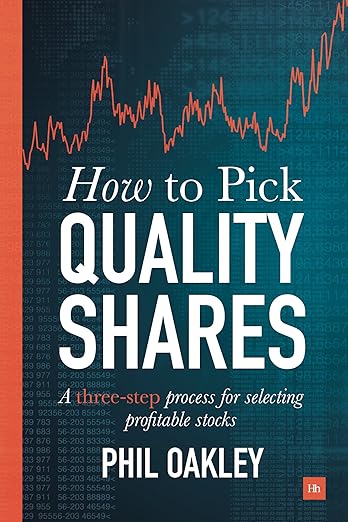
How to Pick Quality Shares
2017 Phil Oakley
Harriman House Ltd.
Chapter Value Investing -
02.0009 Berkshire Hathaway Common Stock Portfolio 1977 to 2012
Berkshire Hathaway Common Stock Portfolio
Company Sector Cost (mil) Market Value (mil) P&L % Core Business Year Affiliated Publication Media 3,516 55,710 1484.47% Media (Newspaper) 1979-1985 (7) Amerada Hess Energy 2,861 5,487 91.79% Energy (Oil & Gas) 1979 (1) American Express Company Financial 1,287 8,715 577.16% Financial (Payment Cards) 1995-2012 (18) Ameriprise Financial, Inc. Financial 183 1,243 579.23% Financial (Wealth Management) 2005 (1) Anheuser-Busch, Inc. Consumer 1,718 1,861 8.32% Manufacturing (Alcoholic Beverage) 2005-2007 (3) Aluminium Company of America Industrial 19,359 18,031 -6.86% Manufacturing (Aluminium products) 1980-1981 (2) American Broadcasting Companies Media 54,435 108,997 100.23% Media (Broadcasting) 1978-1985 (8) Arcata Corporation Consumer 14,076 15,136 7.53% Services (Cleaning Maintenance) 1981 (1) Beatrice Companies, Inc. Media 106,811 108,142 1.25% Media (News & Entertainment) 1985 (1) Burlington Northern Santa Fe Utilities 4,731 5,063 7.02% Utilities (Railway) 2007 (1) BYD Company Ltd. Industrial 232 1,182 409.48% Manufacturing (EV) 2009-2010 (2) Capital Cities Communications, Inc. Media 345.00 2,467.50 615.22% Media (Broadcasting) 1977-1995 (19) Cleveland Cliffs Iron Company Industrial 12,942 14,362 10.97% Manufacturing (flat-rolled steel) 1980-1981 (2) ConocoPhillips Energy 1,291 1,399 8.37% Energy (Oil & Gas) 2006-2012 (7) Crum & Foster Financial 47,144 48,962 3.86% Financial (Insurance) 1982 (1) DirectTV Media 1,057 1,154 9.18% Media (Entertainment) 2012 (1) Exxon Corporation Energy 173,401 175,307 1.10% Energy (Oil & Gas) 1984 (1) Federal Home Loan Mortgage Corp. Financial 333.40 1,772.80 431.73% Financial (Loan Mortgage) 1988-1996 (9) Freddie Mac Financial 294 2,803 853.40% Financial (Loan Mortgage) 1997-1999 (3) F.W. Woolworth Company Consumer 13,583 16,511 21.56% Retail (Variety store) 1979-1980 (2) Gannett Co., Inc. Media 335,216 365,002 8.89% Media (Mass) 1994 (1) GATX Corporation Consumer 17,147 13,466 -21.47% Services (Railcar leasing) 1981 (1) GEICO Common Stock Financial 45.70 2,393.20 5136.76% Financial (Insurance) 1977-1995 (19) General Dynamics Industrial 94,938 401,287 322.68% Manufacturing (Aerospace and Defense) 1992-1993 (2) General Foods, Inc. Consumer 149,870 226,137 50.89% Manufacturing (Food -Snack) 1979-1984 (6) Guinness plc Consumer 333,019 270,822 -18.68% Manufacturing (Alcoholic Beverage) 1991-1993 (3) H&R Block, Inc. Financial 233 703 201.72% Services (Tax) 2001-2004 (4) Handy & Harman Basic Materials 27,318 46,989 72.01% Trading (Silver) 1979-1986 (8) HCA Inc. Healthcare 492 665 35.16% Healthcare 2003 (1) International Business Machines Corp Technology 11,680 13,048 11.71% Technology (Computers) 2011-2012 (2) Interpublic Group of Companies Media 2,570 28,149 995.29% Media (Advertising) 1977-1984 (8) Johnson & Johnson Healthcare 1,880 2,060 9.57% Manufacturing (Pharmaceutical) 2006-2011 (6) Kaiser Aluminium and Chemical Corp. Industrial 20,629 27,569 33.64% Manufacturing (Aluminium products) 1977-1980 (4) Kaiser Industries, Inc. Industrial 778 6,039 676.22% Manufacturing (Industrial Chemical) 1977 (1) Kraft Foods, Inc. Consumer 2,589 2,953 14.06% Manufacturing (Food) 2007-2011 (5) Knight-Ridder Newspaper Media 7,534 10,267 36.28% Media (Newspaper) 1977-1978 (2) Lear Siegler, Inc. Industrial 44,064 44,587 1.19% Manufacturing (Aerospace and Defense) 1986 (1) M&T Bank Corporation Financial 103 820 696.12% Financial (Bank) 2003-2006 (4) McDonald’s Corporation Consumer 1,265.30 1,368.40 8.15% Retailer (Food Service) 1996 (1) Media General, Inc. Media 3,191 11,191 250.71% Media (Broadcasting) 1979-1983 (5) Moody’s Corporation Financial 287 1,430 398.26% Services (Risk Assessment) 2001-2012 (12) Munich Re Financial 2,990 3,599 20.37% Financial (Insurance) 2010-2012 (3) National Detroit Corporation Industrial 5,930 6,299 6.22% Manufacturing (Power Hand Tools) 1980 (1) National Student Marketing Media 5,128 5,895 14.96% Services (Marketing) 1980 (1) Northwest Industries Industrial 26,581 27,242 2.49% Industrial (Railroad) 1984 (1) Ogily & Mather International Media 2,580 12,833 397.40% Media (Advertising) 1977-1983 (7) PetroChina Company Limited Energy 488 1,915 292.42% Energy (Oil & Gas) 2003-2006 (4) Phillips 66 Energy 660 1,097 66.21% Energy (NGL) 2012 (-) Pinkerton’s, Inc. Consumer 12,144 19,675 62.01% Services (Security firm) 1980-1981 (2) PNC Bank Corporation Financial 503,046 410,951 -18.31% Financial (Asset Management) 1994 (1) POSCO Industrial 768 1,295 68.62% Manufacturing (Steel) 2006-2012 (7) R.J. Reynolds Industries Consumer 268,918 314,334 16.89% Manufacturing (Tobacco) 1980-1983 (4) SAFECO Corporation Financial 21,329 31,016 45.42% Financial (Insurance) 1978-1981 (4) Sanofi-Aventis Healthcare 2,073 2,438 17.61% Healthcare (Pharmaceutical) 2007-2012 (6) Swiss Re Financial 733 530 -27.69% Financial (Insurance) 2008 (1) Tesco plc Consumer 2,350 2,268 -3.49% Retail (FMCG) 2006-2012 (7) The Coca-Cola Company Consumer 1,299 14,500 1016.24% Manufacturing (Syrup Beverage) 1988-2012 (25) The Gillette Company Consumer 600 4,299 616.50% Manufacturing (Razors) 1991-2004 (14) The Procter & Gambler Company Consumer 336 3,563 960.42% Manufacturing (Personal Care) 2005-2012 (8) The Times Mirror Company Media 4,447 6,271 41.02% Media (Newspaper) 1980 (1) The Walt Disney Company Media 281 1,536 446.62% Media (Entertainment) 1996-1999 (4) The Washington Post Company Media 11 1,367 12327.27% Media (Newspaper) 1977-2008 (32) Time, Inc. Media 20,385 52,669 158.37% Media (Magazines) 1982-1985 (4) Travelers Group Inc. Financial 604.40 1,278.60 111.55% Financial (Insurance) 1997 (1) U.S. Bancorp Financial 2,401 2,493 3.83% Financial (Bank) 2006-2012 (7) USG Corp. Industrial 536 611 13.99% Manufacturing (Construction Material) 2006-2007 (2) Wal-Mart Stores, Inc. Consumer 2,837 3,741 31.86% Retail (Multi Channel) 2005-2012 (8) Wells Fargo & Company Financial 10,906 15,592 42.97% Financial (Bank) 1991-2012 (22) White Mountain Insurance Financial 369 886 140.11% Financial (Insurance) 2004-2007 (4) -
02.0010 Book of Investing Rules
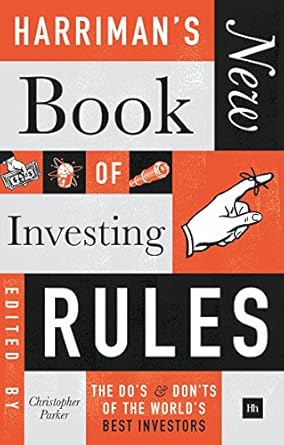
Book of Investing Rules
2017 Christopher Parker
Harriman House
Chapter Value Investing Editor’s Note THIS IS AN argumentative book Foreword by Jonathan Davis There are many styles of investing, and many different asset classes in which to invest, so you will need to pick and choose which of the authorities assembled here best matches your own temperament and interests. Frank Armstrong Investing from the Cockpits
1. Plan Ahead.
2. Find the High-Probability Shot.
3. You need commitment.
4. Expect Turbulence.
5. Undertake Continuous Maintenance.
– Rebalancing to keep the original risk profile.
– Addition of new desirable asset classes.
– Substitution of cheaper funds.
– Dividend avoidance.
– Tax-loss harvesting.
– Conversion of short-term gains to long-term gains.
6. Have a Good Trip.Glen Arnold Investing Tenets of the Private Investor Who Trained the Professionals
1. Understand Before You Buy.
2. Small Investor Can Overperform The Professionals.
3. The Market Is There To Serve You, Not To Guide You.
4. Remember The Difference Between Investing And Speculation.
5. Do Not Pay High Fees.
6. Diversify, But Not To Mediocrity.
7. Study Stock Market Mispricing.
8. Read The Philosophies Of The Great Investors.
9. Keep Your Emotions In Check.
10. Enjoy The Journey.Martin Bamford Britain’s Bestselling Financial Planner on Dealing with Risk and Reward
1. Find your comfort level.
2. Make sure you can still afford to feed the cats.
3. Link our portfolio to goals.John Baron Insights of an Investment Trust Expert
1. Determine your goals.
2. Time in the market is better than market timing.
3. Do not spend your dividends unless you have it.
4. Diversify to reduce portfolio risk.
5. Rebalance – but not too frequently.
6. Be prepared to be a contrarian
7. Seize the advantage.
8. Keep it simple.
9. Be skeptical of ‘Expert’ forecasts.
10. Harness Einstein’s eight wonder
11. Harness the potential of investment trusts.
Website Portfolio: johnbaronportfolios.co.ukAndy Bell How to Be a Successful DIY Investor Alistair Blair 11 Quick Tips for time-Limited Private Investors
1. The longer you hold it, the better you know it.
2. Be clear on selling.
3. A Portfolio of 15-25 shares is enough.
4. Don’t let single holdings exceed 15% of your portfolio.
5. Don’t time markets – Just hold good companies for decades.
6. Don’t Panic, re-evaluate.
7. Forget Falling Shares.
8. Say No to IPOs
9. Beware bad Balance Sheet.
10. Management matters
11. Don’t rush to buy.Michael van Biema Concentrate Value Investing in 6 Simple Steps
1. What matters most is the price paid for the value received.
2. Make time your friend.
3. You need a concentrated portfolio if you don’t want index-like returns.
4. There are lots of pretty good investment ideas and relatively few great ones.
5. Timing is somewhere between very hard and impossible.
6. Ask yourself 3 questions for every share.
– What do I think it is worth?
– Why doesn’t the rest of the world understand what it is worth?
– What is going to make it become what it is worth?John C. Bogle Investing Insights of the $4 Trillion Man
1. There’s no escaping risk.
2. Buy right and hold tight.
3. Time is your friend, impulse your enemy.
4. Realistic expectations: The bagel and the doughnut.
5. Why look for the needle in the haystack? Buy the haystack!
6. Minimize the croupiers’ take
7. Beware of fighting the last war.
8. Sir Isaac newton’s revenge on Wall Street – Reversion to the mean.
9. The hedgehog bests the fox.
10. Stay the course: The secret of investing is that there is no secret.Anthony Bolton Long-Term Lessons from a Legendary Run
1. Understand the business franchise and its quality.
2. Understand the key variables that drive the business.
3. Favor simple over complex businesses.
4. Hear Directly from the management.
5. Avoid ‘Dodgy’ managements at all costs.
6. Try and think 2 moves ahead of the crowd.
7. Understand the balance sheet risk.
8. Seek ideas from a wide range of sources.
9. Watch closely the dealing by company insiders.
10. Re-examine your investment thesis at regular intervals.
11. Forget the price you paid for shares.
12. Past performance attribution is generally a waste of time.
13. Pay attention to absolute valuations.
14. Use technical analysis as an extra indicator.
15. Avoid market timing and major macro bets.
16. Be a contrarian.Jeroen Bos How To Go Deep Value Diving For Bargain Shares
1. Cheapness is not enough.
2. Read Benjamin Graham.
3. Working capital is King
4. Look for new 52-weeks lows, downward charts and then study the balance sheet.
5.Jonathan Boyar Patience Makes Perfect
1. Be patient.
2. Make sure you have the right clients.Ashton Bradbury – Kathleen Brooks – Mike Brooks – David Buik – Robbie Burns – Richard Buxton – Tobias Carlisle Zig When the Investing Crowd Zag
1. Zig when the crowd zags.
2. Buy undervalued companies.
3. Seek a margin of safety.
4. Treat a share as an ownership interest, not a mere ticker symbol.
5. Be wary of high earnings growth and profits.
6. Use simple, concrete rules to avoid making errors.
7. Concentrate, but not too much.
8. Aim to maximize after-tax gains over the long term.
9. Hedge when the market’s expensive and falling.Robert Carver How To Invest Systematically
1. Unless you are a genius use a system.
2. The future is unpredictable.
3. …but some thins are less unpredictable than others.
4. Diversify, diversify, diversify
5. There is no right asset allocation…but there are some wrong ones.
6. Don’t buy individual stocks until it makes sense.
7. Avoid expensive funds
8. Carefully rebalance your portfolio.
9. Stick to your guns – try not to be embarrassed.
10. Be skeptical.Jonathan Clements – Michael Covel – Andrew Craig – Sandy Cross – Lawrence A. Cunningham Warren Buffett’s Investing Rules
1. Don’t be patsy.
2. Operates as a business analysist.
3. Look for a big moat.
4. Exploit Mr. Market.
5. Insist on Safety of Margin.
6. Buy at a reasonable price.
7. Know your limits.
8. Invest with ‘sons-in-law’.
9. Only a few will meet these standards.
10. Avoid gin rummy behavior.Job Curtis – Mark Dampier – Elroy Dimson, Paul March & Mike Staunton – Stephen Eckett – Alexander Elder – Scott Fearon -
02.0008 The Warren Buffett Way
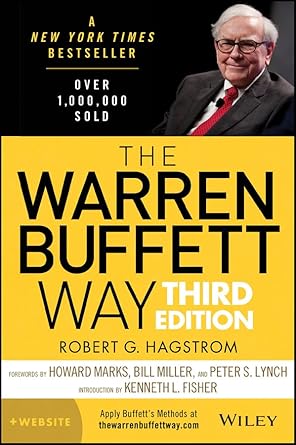
The Warren Buffett Way
2014 Robert G. Hagstrom
John Wiley & Sons, Inc.
Chapter Value Investing Foreword: The Exception (Howard Marks) He started Buffett Partnership in 1956 with $105,000. Since then, he attracted additional capital and earn returns on it such that Berkshire Hathaway now has investments totaling $143 billion and a net worth of $202 billion. Foreword to the 2nd Edition (Bill Miller) And principals do not change. Warren saying “That’s why they call them principles.” Foreword to the 1st Edition (Peter S. Lynch 11 employees. There was not a computer or a stock quotation machine to be found. Personal qualities: very contented, discipline, patience, flexibility, courage, confidence, and decisiveness. To eliminate / minimized risk. He is very depth at probability and as an oddsmaker. Inherent love of simple math computation. He can make a decision not to invest in something in as little as 2 minutes and conclude that it is time to make a major purchase in just a few days of research. Warren states that 12 investment decisions in his 40-year career have made all the difference. Risk can br reduced greatly by concentrating on only a few holdings if it forcrs investors to be more careful and thorough in their resesrch. Normally more than 75 percent of Berkshire’s common stock holdings are represented by only 5 different securities. Berkshire annual report after 1978: The format became more similar to the partnership reports he had produced from 1956 to 1969. Including dos and don’ts of proper investing in stocks. Setting growing intrinsic value by 15 percent a year over the long term. June 1993 annual report on page 60: “Berkshire has not declared a cash dividend since 1967.” Introduction (Kenneth L. Fisher) – Preface “What we do is not beyond anybody else’s competence,” said Buffett. “I feel the same way about managing that I do about investing: It’s just not necessary to do extraordinary things to get extraordinary results.” He thinks about the business, the people who run the business, the economic of the business, and then the value of the business, and in each case he lays wahat he learns against his own benchmarks.
-Investment tenets: business, management, financial, market.1996 annual report: ” Your goal as an investor should be simply to purchase, at a rational price, a part interest in an easily understood business whose earnings are virtually certai to be materially higher, 5, 10, and 20 years from now. Over time, you will find only a few companies that meet those standards – so when you see one that qualifies, you should buy a meaningful amount of stock.” 1. A 5 Sigma Event: The World’s Greatest Investor 60 to 70 pages of dense information annual reports: no pictures, no colour graphics, no charts. He emphasizes both the pluses and the minuses of Berkshire’s businesses. He belives that people who own stock in Berkshire Hathaway are owners of the company, and he tells them as much as he would like to be told if he were in their shoes. 2. The Education of Warren Buffett 1. Benjamin Graham (Quantitative)
2. Phillip Fisher (Qualitative)
3. Charlie Munger (All rounder)Fisher came to believe that superior profits could be made by:
1. investing in companies with above average potential.
2. aligning oneself with the most capable management.2 types of companies would, decade by decade, show promise of above-average growth:
1. those that were “fortunate and able” – Aluminium Company of America (Alcoa)
2. those that were “fortunate because they are able.” – DupontInvaluable link between Marketplace and the research and development unit. Generally, his portfolios included fewer than 10 companies, and 3 or 4 companies represented 75 percent of his entire equity portfolio. 3. Buying Business: The 12 Immutable Tenets Tenets of the Warren Buffett Way
Business Tenets
1. Is the business simple and understandable?
2. Does the business have a consistent operating history?
3. Does the business have favorable long term prospects?
Management Tenets
4. Is management rational?
5. Is management candid with its shareholders?
6. Does management resist the institutional imperative?
Financial Tenets
7. Focus on return on equity, not earnings per share.
8. Calculate “owner earnings.”
9. Look for companies with high profit margins.
10. For every dollar retained, make sure the company has created at least one dollar of market value.
Market Tenets
11. What is the value of the business?
12. Can the business be purchased at a significant discount to its value?4. Common Stock Purchases: 9 Case Studies 1. The Washington Post Company (Freight & Logistics Services)
2. GEICO Corporation (Insurance)
3. Capital Cities/ABC (Broadcasting)
4. The Coca-Cola Company (Consumer – selling syrup)
Tenet 1: Simple and Understandable
Tenet 2: Consistent Operating History
Tenet 3: Favorable Long-Term Prospect
Tenet 4: High Profit Margins
Tenet 5: Return on Equity
Tenet 6: Candor (unreserved, honest, or sincere expression)
Tenet 7: Rational Management
Tenet 8: Owner Earnings
Tenet 9: The Institutional Imperative
Tenet 10: Determine the Value
Tenet 11: Buy at Attractive Prices
5. General Dynamic (Defense Contractor)
6. Wells Fargo & Company (Bank)
7. American Express Company (Charge card, Travelers Cheques – 72% sales, Financial Advisors)
8. International Business Machines – IBM (Technology)
9. H.J. Heinz Company (Consumer)
Tenet: Consistent Operating History
Tenet 1: Favorable Long-Term Prospects
Tenet 2: Determine the Value
Tenet 3: Buy at Attractive Prices
Tenet4 : Rationality5. Portfolio Management: The Mathematics of Investing Focus Investing: We just focus on a few outstanding companies – greatly simplifies the task of portfolio management 6. The Psychology of Investing – 7. The Value of Patience 8. The World’s Greatest Investor Relative outperformance and duration
The Buffett Advantage
1. Behavioral Advantage
2. Analytical Advantage
3. Organizational AdvantageAppendix Berkshire Hathaway Portfolio 1977 to 2012 -
02.0007 Charlie Munger The Complete Investor
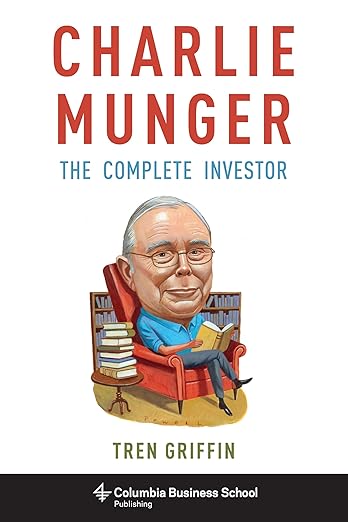
Charlie Munger The Complete Investor
2015 Trend Griffin
Columbia Business School Publishing
Chapter Value Investing Introduction Munger: I’m a great believer in solving hard problem by using a checklist. You need to get all the likely and unlikely answers before you; otherwise it’s easy to miss something important.
Buffett: If you cannot write it down, you have not thought it through.The 4 fundamental principles of value investing as created by Ben Graham are as follows:
1. Treat a share of stock as a proportional ownership of the business.
2. Buy at a significant discount to intrinsic value to create a margin of safety.
3. Make a bipolar Mr. Market your servant rather than you master.
4. Be rational, objectives, and dispassionate.1. The Basics of Graham Value Investing System If you cannot accept investing underperformance in the short term in order to achieve long-term investment outperformance, then you are not a candidate for Graham value investing. Graham value investing would not work if markets were perfectly efficient. For this reason, the market’s folly is the fundamental source of the Graham value investor’s opportunity. 2. The Principles of the Graham Value Investing System 1. Treat a Share of Stock as a Proportional Ownership of a Business.
2. Buy at a Significant Discount to Intrinsic Value to Create a Margin of Safety.
3. Make “Mr. Market” Your Servant Rather Than Your Master.
4. Be Rational, Objectives, and Dispassionate.3. Worldly Wisdom Munger believes that by using a range of different models from many different disciplines – psychology, history, mathematics, physics, philosophy, biology, and so on – a person can use the combined output of the synthesis to produce something that has more value than the sum of its parts. Buffett added that Munger has ” the best 30 second mind in the world. He goes from A to Z in one move. He sees the essence of everything before you even finish the sentence.” The most extreme mistakes in Berkshire’ history have been mistake of omission (Wal-Matt, Television Station):
1. Doing nothing – what Buffett calls “sucking my thumb”
2. Buying with eyedropper things we should be buying a lot of.To be wise, one must also have experience, common sense, and good judgement. How one actually applies these things in life is what make a person wise. 4. The Psychology of Human Misjudgment – 5. The Right Stuff 1. Patient
2. Disciplined
3. Calm but Courageous and Decisive
4. Reasonably Intelligent but Not Misled by Their High IQs
5. Honest
6. Confident and Nonideological
7. Long-Term Oriented
8. Passionate
9. Studious
10. Collegial
11. Sound Temperament
12. Frugal
13 Risk Averse6. The 7 Variables in the Graham Value Investing System 1. Determining the Appropriate Intrinsic Value of a Business
2. Determining the Appropriate Margin of Safety
3. Determining the Scope of an Investor’s Circle of Competence
4. Determining How Much of Each Security to Buy
5. Determining When to Sell a Security
6. Determining How Much to Bet When You Find a Misprices Asset
7. Determining Whether the Quality of a Business Should Be Considered7. The Right Stuff in Business 1. Capital Allocation Skills
2. Compensation Systems That Create Alignment with Shareholders
3. Moat – Widening Skills
4. Management Already in Place with Integrity
5. The Rare Exceptional ManagerBerkshire Math 1. Calculation: In making intrinsic value calculation – discount to Present Value, conservative growth rate
2. Decision making: based on opportunity costs
3. Risk assessment: current earnings are nearly certain to continue
4. Investing process: focus on ROE, not EPS / PE ratio / EBITDA
5. Genuine Free Cash Flow (FCF)Moats 1. Supply-Side Economics of Scale and Scope
2. Demand-Side Economics of Scale (Network Effects)
3. Brand
4. Regulation
5. Patent and Intellectual PropertyBerkshire moat:
1. Berkshire Is Tax Efficient
2. Berkshire Has Low Overhead
3. Berkshire is the Private Buyer of First Resort
4. Berkshire Has Permanent Capital
5. Berkshire Outperforms in Down Markets
6. Berkshire Benefits from Float
7. High-Quality Shareholders, Including Buffett and MungerValue Investing vs, Factor Investing Ben Graham, Warren Buffett, Howard Marks and Seth Klarman – Value Investing: value investors are solving for where can one find low risk of permanent impairment of capital and a high probability of an attractive return. Eugene Fama and Ken French – Factor Investing (Value Stocks): Is solving for what creates a persistent disparity of return across large numbers of stocks. -
02.006 Warren Buffett Speaks
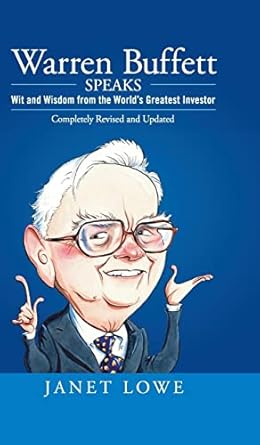
Warren Buffett Speaks
2007 by Janet Lowe
John Wiley & Sons, Inc.
Chapter Value Investing ABOUT LIFE – ABOUT FRIENDS – ABOUT FAMILY – ABOUT WORK – ABOUT RUNNING A BUSINESS Communicate well
Know when you say no
Set an example
Take care of shareholders
Hire well, manage little
Put a premium on experience
Be smart about allocating capital
Be brave
use crossover skills
The mighty machine called Berkshire HathawayABOUT INVESTING Have a philosophy
Recognize the enemy: inflation
Experience epiphany
Never mind what the professors say
Meet Mr. Market – your servant, not your guide
Ignore Mr. Market’s moods
Listen for opportunity’s call
Know the difference between price and value
Seek intrinsic value
Expect to be out of step
Earnings, earnings, earnings
Look forward, not back
Avoid risk
Don’t gamble
Watch for unusual circumstances
Don’t be surprised by circumstances
Avoid excessive debt
Look for screaming bargains
Arbitrage when possible
Be patient
Think for yourself
Have the right tools
Be wary of Wall Street
Only buy securities that you understand
An old dog prowls new markets
PetroChina
An expanding circle of competence
Buy reading glasses
Become an investigative reporter
Keep it simple
Think big
Know what you’re looking for
Don’t sweat the math
Admire frugality
Set realistic goals
Face facts
Expect change
Be capable of change
Admit your mistakes
No thumb sucking
John AA (Airlines Anonymous)
Learn from your mistakes
Buy storybook stocks
Seek excellent companies
Stick with quality
Junk bonds
Appreciate franchise value
Respect pricing power
Find a company with cheat float (then try to not misplace the company)
Learn to like Monopoly
Find managers who think like owners
Management is important, but a good company is more important
Avoid the institutional Imperative (the tendency for corporations to act like lemmings)
Favor companies that repurchase their own stock
Don’t worry about diversification
Invest for the long term
To sum up
And when you’ve become wealthy by following in the footsteps of Buffett, pay your dues to society
Investing is one way of contributing to the public well-being
When rewards are disproportionate
Pay your taxes and don’t complain
Give as generously as you receive
Thoughts on charitable giving -
02.0005 Richer, Wiser, Happier
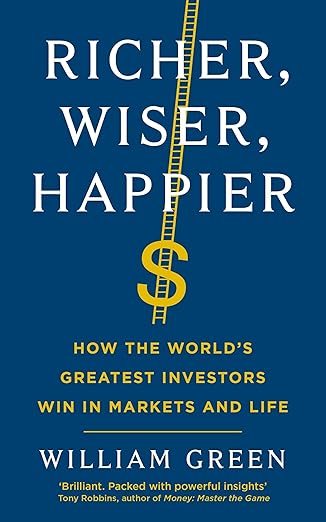
Richer, Wiser, Happier
2012 William Green
Chapter Smart Investing Introduction: Inside the minds of the Greatest Investors Bill Ruane:
1. Do not borrow money to buy stock.
2. Watch out for momentum – proceed with extreme caution.
3. Ignore market prediction.
4. Invest in a small number of stocks that you’ve researched so intensively that you have an informational advantage.1. The Man Who Cloned Warren Buffett Mohnish Pabrai: By cloning Buffett – and later, his polymathic partners, Charlie Munger. On 3 core concept.
1. Whenever you are buy a stock, you’re purchasing a portion of an ongoing business with an underlying value, not just a piece of paper for speculators to trade.
2. Stock prices frequently fail to reflect the true value of these businesses.
3. You should buy a stock only when it’s selling for much less than your conservative estimate of its worth.Lesson from Monish:
Rule 1: Clone like crazy.
Rule 2: Hang out with people who are better than you.
Rule 3. Treat life as a game, not as a survival contest or a battle to the death.
Rule 4: Be in alignment with who you are; don’t do what you don’t want to do or what’s not right for you.
Rule 5: Live by an inner scorecard; don’t worry about what others think of you; don’t be defined by external validation
Munger’s :”Take a simple idea and take it seriously.”2. The Willingness to Be Lonely Sir John Templeton: “You have to buy at time when other people are desperately trying to sell.” 6 Guiding Principles for the Nontribal Investors:
1. Beware of emotion.
2. Beware of your own ignorance.
3. You should diversify broadly to protect yourself from your own fallibility
4. Successful investing requires patience.
5. The best way to find bargains is to study whichever assets have performed most dismally in the past 5 years, then to assess whether the cause of those woes is temporary or permanent.
6. As an investor is not to chase fads (crowd madness).3. Everything Changes – 4. The Resilient Investor Jean-Marie Eveillard: His new investment strategy was built on one all-important insight that he drew from The Intelligent Investor. “Because the future is uncertain, you want to minimize your risk.” says Eveillard. 5 Rules for Resilience
1. We need to respect uncertainty.
2. It’s important to reduce or eliminate debt, avoid leverage, and beware of excessive expenses, all of which can make us dependent on the kindness of stranger.
3. Instead of fixating on short-term gains or beating benchmarks, we should place greater emphasis on becoming shock resistant, avoiding ruin, and staying in the game.
4. Beware of overconfidence and complacency.
5. We should be keenly aware of our exposure t risk and should always require a margin of safety.5. Simplicity Is the Ultimate Sophistication Will Danoff’s Secret Sauce: Stocks follow earnings. Greenblatt: If you bought a stock for much less than its intrinsic value, other investors would figure it out sooner or later and drive up the price. I didn’t see how I was going to lose much money. “I don’t buy more of the ones I can make the most money on. I buy more of the ones that I can’t lose money on.
Cheap + Good = The Holy Grail
Buying cheap is great – and if I can buy good businesses cheap, even better.
Buy Good businesses at a bargain price.
It’s not enough to find a smart strategy that stacks the odds in your favor over the long haul. You also need the discipline and tenacity to apply that strategy consistently, especially when it’s most uncomfortable.
Principles underpinning his strategy:
1. Stocks are ownership shares of businesses, which must be valued.
2. They should be bought only when they trade for less than they are worth.
3. In the long run, the market is rational and will (more or less) reflect the fair value of these businesses.4 Simple Lessons:
1. You don’t need the optimal strategy. You need a sensible strategy that’s good enough to achieve your financial goals.
2. Your strategy should be so simple and logical that you understand it, believe in it to your core, and can stick with it even in the difficult time when it no longer seems to work.
3. You need to ask yourself whether you truly have the skills and temperament to beat the market.
4. It’s important to remember that you can be a rick and successful investor without attempting to beat the market.6. Nick & Zak’s Excellent Adventure Nick Sleep & Qais “Zak” Zakaria (Nomad Investment Partnership, Nomad means far more to us than simply managing a fund). Crazy bargain in Singapore, Hong Kong and the Philippines. Most brokers focused on popular assets that were easy to sell. 5 Key lessons to be learned from Sleep and Zakaria:
1. To pursue quality as a guiding principle in business, investing, and life – moral and intellectual commitment inspired by Zen and the Art of Motocycle Maintenance.
2. The ideal of focusing on whatever has the longest shelf life, which always downplaying the ephemeral.
3. There is the realization that one particular business model – scale economies shared – creates a virtuous cycle that can generate sustainable wealth over long periods.
4. It’s not necessary to behave unethically or unscrupulously to achieve spectacular success, even in a voraciously capitalistic business where self-serving behavior is the norm.
5. In the world that’s increasingly geared toward short-termism and instant gratification, a tremendous advantage can be gained by those who move consistently in the opposite direction.7. High Performance Habits Tom Gayner: Resounding victories tend to be the result of small, incremental advances and improvements sustained over long stretches of time.
Make you mistake non-fatal. It’s so fundamental to longevity, and ultimately, that’s what success is in the business: Longevity.
You don’t need to be extreme to achieve exceptional long-term results. On the contrary, he says, “People get themselves into trouble with extremes.”
You cannot control the outcome. You can only control the effort and the dedication and the giving of 100% of yourself to the task at hand. And then whatever happens, happens.8. Don’t Be a Fool “The Grand Master of Stupidity Reduction”: He (Charlie Munger) focusses so much attention on avoiding common errors and predictable pattern of irrationality – Principle of Inversion. “What We Don’t Do”: Carlie and I (Warren Buffett) avoid businesses whose futures we can’t evaluate, no matter how exciting their products may be, sticking instead with businesses whose profit picture for decades to come seems reasonably predictable. Munger: The more transparently he reviews his mistakes, the less likely he is to repeat them (not buying Google, blew Walmart when is was a total cinch) “Defensive Principles and Practices” (Tillinghast): Don’t pay too much. Don’t go for businesses that are prone to obsolescence and destruction. Don’t invest with crooks and idiots. Don’t invest in things you don’t understand. A Portfolio packed with undervalued, understandable, financially stable, profitable and growing businesses run by honest people. “Discipline Growth Investors” (Fred Martin): Mid-cap stocks min. 12% per year, small caps min. 15% per year, a standardized requirements force him systematically to buy stocks only when they are a sufficiently attractive proposition. He never invest more than 3% of his assets in a stock at the time of purchase. Typically, he owns 45 to 50 stocks. Beware of Your Brain: Psychological tendencies – standard thinking errors, misjudgment. Epilogue Dilgo Khyentse rinpoche, a Tibetan Buddhist master who was a teacher of the Dalai Lama, once said, “Those who seek happiness in pleasure, wealth, glory, power, and heroics are as naive as the child who tries to catch a rainbow and wear it as a coat” -
02.0004 The Intelligent Investors
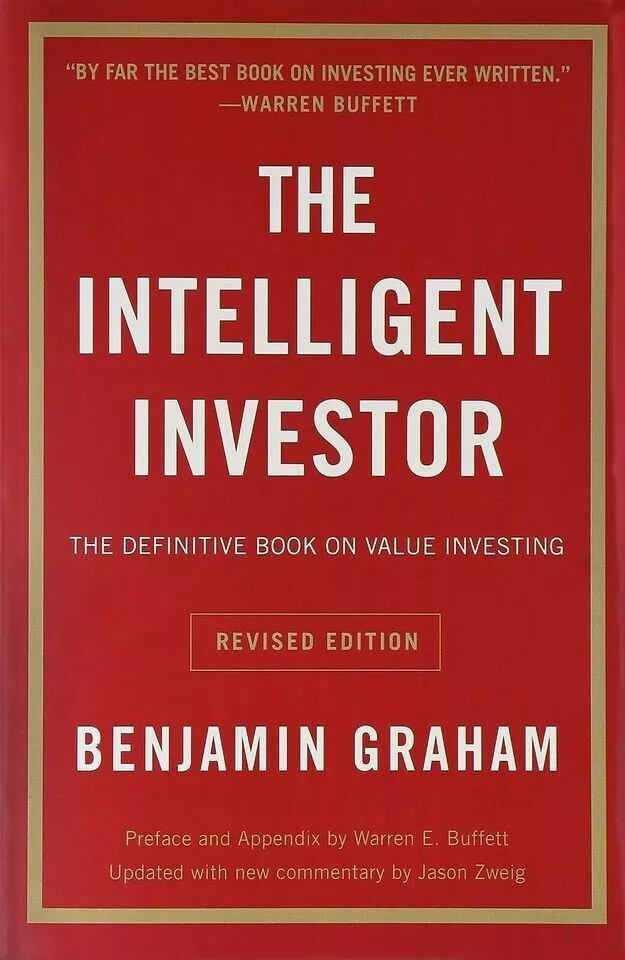
The Intelligent Investor (Revised Edition)
2003 Benjamin Graham / Jason Zweig
Bibliophilist Publisher Books
Chapter Value Investing Preface to 4th Edition, by Warren Buffett if you pay special attention to the invaluable advice in Chapter 8 and 20 – you will not get a poor result from your investment. A note About Benjamin Graham, by Jason Zweig Before Graham, money manager behaved like a medieval guild, guided largely by superstition, guesswork, and arcane rituals.
The Intelligent Investor is the 1st book ever to describe, for individual investors, the emotional framework and analytical tools that are essential to financial success. It remains the single best book on investing ever written for the general public.Graham core principles:
1. A stock is not just a ticker symbol or an electronic blip; it is an ownership interest in an actual business, with an underlying value that does not depend on its share price.
2. The market is a pendulum that forever swing between unstainable optimism (which makes stocks too expensive) and unjustified pessimism (which makes them too cheap). The intelligent investor is a realist who sells to optimists and buys from pessimists.
3. The future value of every investment is a function of its present price. The higher the price you pay, the lower your return will be.
4. No matter how careful you are, the one risk no investor can ever eliminate is the risk of being wrong. Only be insisting on what Graham called the “margin of safety” – never overpaying, no matter how exciting an investment seems to be – can you minimize your odds or error.
5. The secret to your financial success is inside yourself.The goal of the revised edition of The Intelligent Investor is to apply Graham’s ideas to today’s financial market while leaving his text entirely intact (with the exception of footnotes for clarification) Introduction This is not a “How to make a million” book. This book is directed to investors not speculators or those trade in the market. Commentary On The Introduction This book will not tell you how to beat the market, No truthful book can. Instead, this book will teach you 3 powerful lessons:
1. How you can minimize the odds of suffering irreversible losses.
2. How you can maximize the chances of achieving sustainable gains.
3. How you can control the self-defeating behavior that keeps most investors from reaching their full potential.1. Investment versus Speculation Results to Be Expected by the Intelligent Investors Defensive investor: The simplest choice would be to maintain 50:50 proportion. Reduce the common stock component to 25% “if he felt the market was dangerously high,” and conversely to advance it toward the maximum of 75% “if he felt that a decline in stock prices was making them increasingly attractive.” Commentary on 1. – 2. The Investor and Inflation – Commentary on 2. – 3. A Century of Stock Market History – Commentary on 3. – 4. General Portfolio Policy: The Defensive Investor The rate of return sought should be dependent, rather, on the amount of intelligent effort the investor is willing and able to bring to bear on his task. Commentary on 4. Graham: There are 2 ways to be an intelligent investors:
1. by continually researching, selecting, and monitoring a dynamic mix of stocks, bonds, or mutual funds. (Active or enterprising – Physically and intellectually taxing).
2. or by creating a permanent portfolio that runs on autopilot and requires no further effort (but generates very little excitement). (Passive or defensive – emotionally demanding).Charles Ellis: If you have time to spare, are highly competitive, think like a sports fan, and relish a complicated intellectual challenge, then the active approach is up you alley. If you always feel rushed, crave simplicity, and don’t relish thinking about money, then the passive approach is for you. Rebalancing Portfolio every 6 months, no more and no less. The beauty of this periodic rebalancing is that it forces you to base your investing decisions on a simple, objective standard. 5. The Defensive Investor and Common Stocks 4 Rules for defensive investor:
1. Diversification: 10 issues < x < 30 issues
2. Each company selected should be large, prominent, and conservatively financed.
3. Each company should have a long record of continuous dividend payments.
4. Impose some limit on the price he will pay, PE <25 times (7 years average earnings), PE <20 (over last twelve months). This will eliminate growth stocks.A true Growth stock should be expected at least to double its per-share earnings in 10 years (with compounded annual rate of over 7%). Commentary on 5. – 6. Portfolio Policy for the Enterprising Investor: Negative Approach – Commentary on 6. – 7. Portfolio Policy for the Enterprising Investor: Positive Side The activities specially characteristic of the enterprising investor in the common-stock field may be classified under 4 heads:
1. Buying in low markets and selling in high markets.
2. Buying carefully chosen “growth stocks”
3. Buying bargain issues of various types
4. Buying into “special situations”Commentary on 7. In an ideal world, the intelligent investor would hold stocks only when they are cheap and sell them when they become overpriced, then duck into the bunker of bonds and cash until stocks again become cheap enough to buy. 8. The Investor and Market Fluctuations Since common stocks, even of investment grade, are subject to recurrent and wide fluctuations in their prices, the intelligent investor should be interested in the possibilities of profiting from these pendulum swings. There are 2 possible ways by which he may try to do this: the way of timing and the way of pricing.
1. By timing, we mean the endeavor to anticipate the action of the stock market – to buy or hold when the future course is deemed to be upward, to sell or refrain from buying when the course is downward.
2. By pricing we mean the endeavor to buy stocks when they are quoted below their fair value and to sell them when they rise above such value.Commentary on 8. Mr. Market: When stocks are going up, he happily pays more than their objective value; and, when they are going down, he is desperate to dump them for less than their true worth. 9. Investing in Investment Fund – Commentary on 9. – 10. The Investor and His Advisers – Commentary on 10. – 11. Analysis for the Lay Investor: General Approach Financial analysis is now a well-established and flourishing profession, or semi-profession. Financial analysists have textbooks, a code of ethics, and a quarterly journal. They also have their share of unresolved problems. Factors Affecting the Capitalization Rate:
1. General Long-Term Prospects: price/earnings ratios.
2. Management: An outstandingly successful company has unusually good management.
3. Financial Strength and Capital Structure: Stock of a company with a lot of surplus cash and nothing ahead of the common is clearly a better purchase (as the same price) than another one with the same per share earnings but large bank loans and senior securities. Such factors are properly and carefully taken into account by security analysists. A modest amount of bonds or preferred stock, however, is not necessarily a disadvantage to the common, nor is the moderate use of seasonal bank credit.
4. Dividend Record: uninterrupted record of dividend payments going back over many years.
5. Current Dividend Rate: 12x earnings or x18 dividendsValuation of growth stock (over the next 7 to 10 years):
Value = Current (Normal) Earnings x [8.5 x (1+ 2 x annual growth rate)]Commentary on 11. Graham’s 5 decisive elements – Putting a Price on the Future
1. the company’s “general long-term prospect”
2. the quality of the management
3. the financial strength and capital structure
4. its dividend record
5. and its current dividend rate12. Things to Consider About Per-Share Earnings 1. Don’t take a single year’s earnings seriously.
2. If you do pay attention to short-term earnings, look out for booby traps in the per-share figures (i.e. special charges or credits – closing down losses and future losses might not be reflected, dilution – large bond issue convertible into common stock will reduce the earnings).To use Average Earnings over a long period in the past (7 to 10 years) – solve the problem of special charges and credits. Commentary on 12. A few pointers will help you avoid buying a stock that turns out to be an accounting time bombs:
1. Read backwards: Anything that the company doesn’t want you to find out is buried in the back – which is precisely why you should look there first.
2. Read the notes: Never buy a stock without reading the footnotes to the financial statements in the annual report. Usually labeled “summary of significant accounting policies”.
3. Read more: If you are an enterprising investor willing to put plenty of time and energy into your portfolio, then you owe it to yourself to learn more about financial reporting.13. A Comparison of Four Listed Companies – Commentary on 13. – 14. Stock Selection for the Defensive Investor Graham’s criteria for Stock Selection:
1. Adequate size of the Enterprise.
2. A sufficiently Strong Financial Condition.
3. Earnings Stability.
4. Dividend Record.
5. Earnings Growth.
6. Moderate Price/Earnings Ratio,
7. Moderate Ratio of Price to AssetsQualitative Approach: It emphasizes prospects , management, and other non-measurable, albeit highly important, factors that go under the heading of quality.
Quantitative Approach (Statistical Approach): It emphasizes the measurable relationships between selling price and earnings, assets, dividends, and so forth. Incidentally, the quantitative method is really an extension – into the field of common stock – of the viewpoint that security analysists has found to be sound in the selection of bonds and preferred stocks for investment.Commentary on 14. Defensive investor: Keep 90% of your stock money in an index fund, leaving 10% with which to try picking your own stocks.
Due Diligence:
1. Do you homework: Access to a company’s annual and quarterly reports, along with the proxy statement that discloses the managers’ compensation, ownership, and potential conflict of interest.
2. Check out the neighborhood: Check what percentage of a company’s shares are owned by institutions. Anything over 60% suggests that a stock is scarcely undiscovered and probably “over-owned”. If there are money management firms that invest in a style similar to your own, that’s a good sign.15. Stock Selection for the Enterprising Investor – Commentary on 15. – Practice, practice, practice
– Looking under the right rocks
– Who’s the Boss? Are the company’s financial statements easily understandable, or are they full of obfuscation? Are “nonrecurring” or “extraordinary” or “unusual” charges just that, or do they have a nasty habit of recurring?
– Keeping your eye on the roadSuccessful Investing professionals have 2 things in common:
1. They are discipline and consistent.
2. They think a great deal about what they do and how to do it, but they pay very little attention to what the market is doing.16. Convertibles Issues and Warrants – Commentary on 16. – 17. Four Extremely Instructive Case Histories – Commentary on 17. – 18. A Comparison of Eight Pairs of Companies – -
02.0003 股票分析投资揭秘
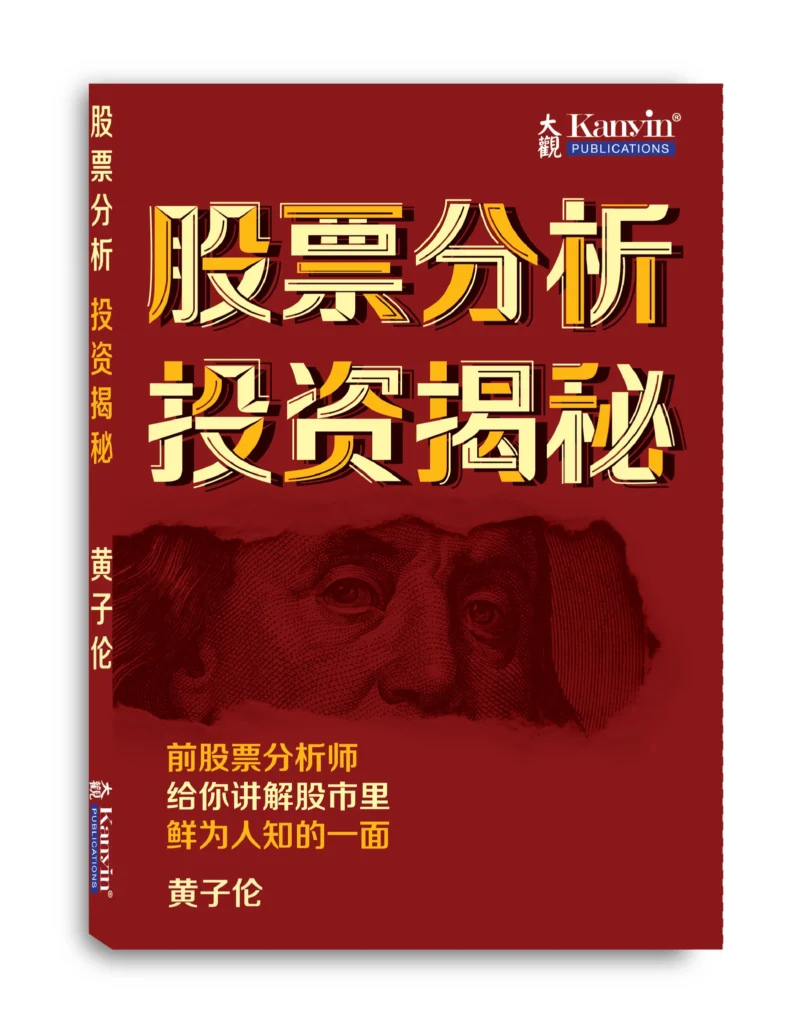
股票分析投资揭秘
2022 黄子伦
Kanyin Publications Sdn Bhd
Chapter Value Investing -
02.0002 决战股市终极方案
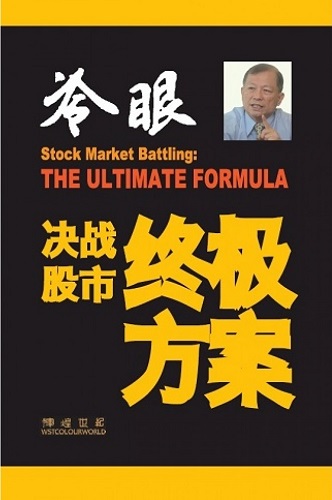
决战股市终极方案
2020 冯时能 (冷眼)
Wstcolourworld Sdn Bhd
Chapter Value Investing 目录 作者自序 第一辑:沉思录 第二辑:决战股市终极方案
